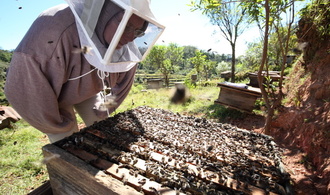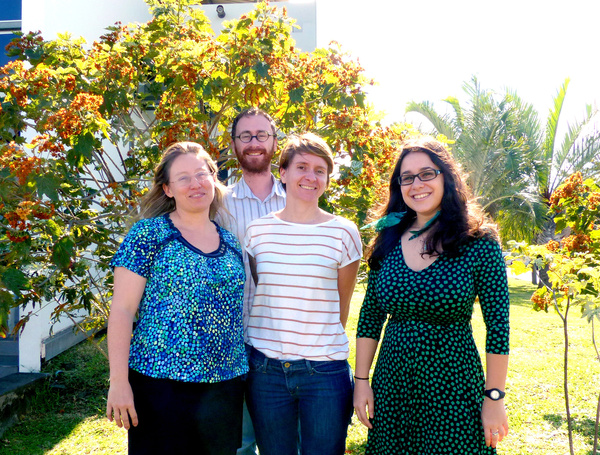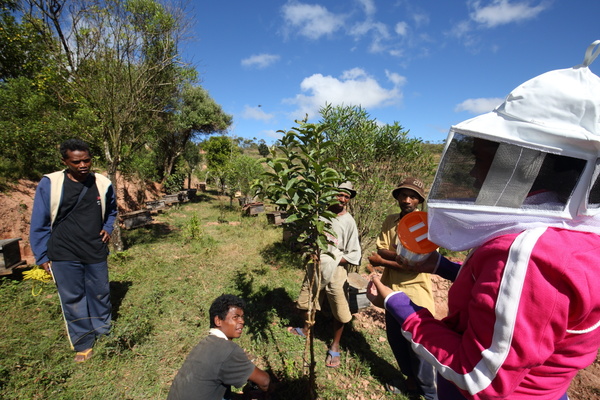Honeybees of the Indian Ocean Islands: a diversity that must be preserved
Written by Modified on the
Local honeybees are of major importance for both the economy and the environment. On the islands of the Southwest Indian Ocean, apiculture is an important activity, especially in Reunion Island, Madagascar, Mauritius and the Seychelles. The preservation of bees, which are essential for the pollination of plants, requires a better knowledge of their diversity.
With this aim in view, the research teams of the UMR PVBMT (CIRAD and the University of Reunion Island) and of the University of Antananarivo in Madagascar have conducted an inventory of the genetic diversity of the subspecies that can be found in the region. While the practice of intensive apiculture in the world leads to a decline in bee diversity, the first results show that the islands in the South West of the Indian Ocean provide a habitat for a genetic heritage that must be preserved.
Lineages andbiogeography of bees:
The bees used in apiculture belong to the species Apis mellifera with worldwide geographical distribution. This wide distribution indicates a capacity to adapt to different ecological situations and that results in genetic variability within the species. This is called lineages and subspecies. One lineage corresponds to a set of subspecies with a common evolutionary history. The species Apis mellifera has four genetic lineages characterized by a strong geographic structure, as a result of thousands of years of evolution:
- A lineage comes from Africa;
- C and M lineages come from Europe;
- and O lineage comes from Asia.
Present in a large number of countries with different climates and a varied flora, subspecies have appeared within these lineages, out of which at least 28 have been identified. These are also referred to as geographical races. They result from adaptations to their environment – namely their morphology, their behaviour or a variable cycle of development from one region to another.
In the Indian Ocean, only the endemic subspecies A. mellifera unicolor had been identified in Madagascar. In order to learn more about the subspecies in the other SWIO islands, an inventory of the genetic diversity of the bee was conducted under the ePRPV project[1]. Launched in 2012, this study was conducted by PhD student Maéva Techer under the co-supervision of Hélène Delatte, a CIRAD researcher (PVBMT Joint Research Unit) and Johanna Clemencet, a lecturer at the University of Reunion Island (PVBMT Joint Research Unit). It required a close partnership with scientists and government actors of the Indian Ocean islands.
A regional mobilization to collect samples
From 2012 to 2014, three missions were organized in the SWIO islands to sample bees in apiaries and in the wild. In November 2012, 355 samples were collected in Mauritius under the coordination of the Entomological division of the island’s Ministry of Agriculture.
In January 2013, 186 samples from all apiaries were brought from the three Seychelles islands with the support of the Seychelles Agricultural Agency. In February 2013, 524 samples were collected from 20 sites in Rodrigues with the support of the Entomological Division of the Mauritius Ministry of Agriculture.
In Madagascar, samples were taken by Henriette Rasolofoarivao as part of her thesis which is co-supervised by the University of Madagascar, CIRAD and the University of Reunion Island. The samples come from 867 bee colonies over 76 different geographical sites on the island. Finally, samples were brought back from the Comoro islands by Dr. Abdou Azali Hamza, a researcher at INRAPE.
Genome analysis, key to the geographicalorigin of bees
Data analysis is based on the use of two molecular markers, mitochondrial DNA and nuclear DNA, making it possible to understand the biogeography of the bee. Mitochondrial DNA, transmitted exclusively by maternal route, provides information on the genotype of the queen and therefore on the maternal origin of the colony. It enables an initial identification of the lineage and subspecies involved, which will be confirmed by analysing the cell nucleus DNA.
The nuclear genome is transmitted amongst worker bees by both the maternal and paternal routes. The study of the nuclear genome, from a group of workers bee determines the genotypes of the males that inseminate the queen. Combining the two methods makes it possible to identify the genetic lineage - and therefore the geographic origin - of the bees studied by highlighting any crossbreeding between subspecies.
Initial results: a diversity that must be preserved
The initial results of the study of the genetic diversity of bees in the SWIO Islands show a unique heritage. They show that all the bees collected in Madagascar, the Comoros Islands and the Seychelles originate from the African lineage and mainly belongs to the subspecies A. mellifera unicolor, endemic to Madagascar. In Mauritius, half of the samples come from European lineages and the other half are of African origin.
Finally, the bees collected in Rodrigues come entirely from the European lineage. Among European lineages found, the subspecies Apis mellifera carnica and A. mellifera ligustica were identified. These variations could be explained by different import policies of bees between islands. Bees from European lineages could have been imported in Mauritius, then in Rodrigues which economically depends on Mauritius
Furthermore, the results show that within the African lineage samples, there is a sufficiently large genetic variability between the bees of each island to indicate that their radiation from Madagascar occurred well before the advent of humans. It would thus seem that the bees arrived on the SWIO islands naturally and adapted to their new environment, resulting in genetic divergence within their genome. Although we cannot yet speak of subspecies, the study shows a remarkable genetic diversity despite the small size of the SWIO islands. The diversity of bees in these islands constitutes a unique heritage that deserves special attention.
Another study in progress suggests that the bees in the region have floral preferences. The conservation of traditional apiculture requires preservation of the local flora, since bees are dependent upon it. Pending the finalization of the study on their diversity, two publications on the genetic characterization of bee populations in Rodrigues[2] and Madagascar[3] have already appeared in Apidologie a renowned scientific journal on bees. A publication on the work undertaken in the Seychelles is in progress.
[1] Élargissement et Pérennisation du Programme Régional de Protection des Végétaux - Enlargement and Sustainability of the Plant Protection Network
[2] Genetic characterization of the honeybee (Apis mellifera) population of Rodrigues Island, based on microsatellite and mitochondrial DNA - Techer M.A., Clémencet J., Turpin P.,Volbert N., Reynaud B., Delatte H .2014.Genetic characterization of the honeybee (Apis mellifera) population of Rodrigues Island, based on microsatellite and mitochondrial DNA. Apidologie , 1-10 .DOI10.1007/s13592-014-0335-9 - http://umr-pvbmt.cirad.fr
[3] Genetic diversity of the endemic honeybee : Apis mellifera 3 unicolor (Hymenoptera: Apidae) in Madagascar- Rasolofoarivao, H., Clémencet, J., Techer, M., Ravaomanarivo, L., Reynaud,B., Delatte, H. 2015. Genetic diversity of the endemic honeybee: Apis mellifera unicolor (Hymenoptera: Apidae) in Madagascar. Apidologie, 1-13, DOI10.1007/s13592-015-0362-1. Online first - http://umr-pvbmt.cirad.fr





